University Emergency Department Treatment Analysis and Improvement
VerifiedAdded on 2023/02/01
|12
|2728
|33
Report
AI Summary
This report provides an in-depth analysis of the emergency treatment process within a hospital setting, focusing on identifying and analyzing system archetypes that impede performance. The report begins with an executive summary, followed by an introduction and background detailing the issues of patient wait times and inefficiencies in the emergency department. The core of the report involves identifying archetypes such as Limits to Growth, Eroding Goals, Escalation, and Tragedy of the Commons and their impact on the current state Value Stream Map. The report then proposes a new State Value Stream Map designed to reduce treatment times, incorporating the archetype of Shifting the Burden through the implementation of an Electronic Health Record system to redistribute tasks. Finally, the report discusses the potential consequences of the new Value Stream Map and offers recommendations for further process improvement. The goal is to enhance the efficiency of the emergency department and reduce patient wait times.
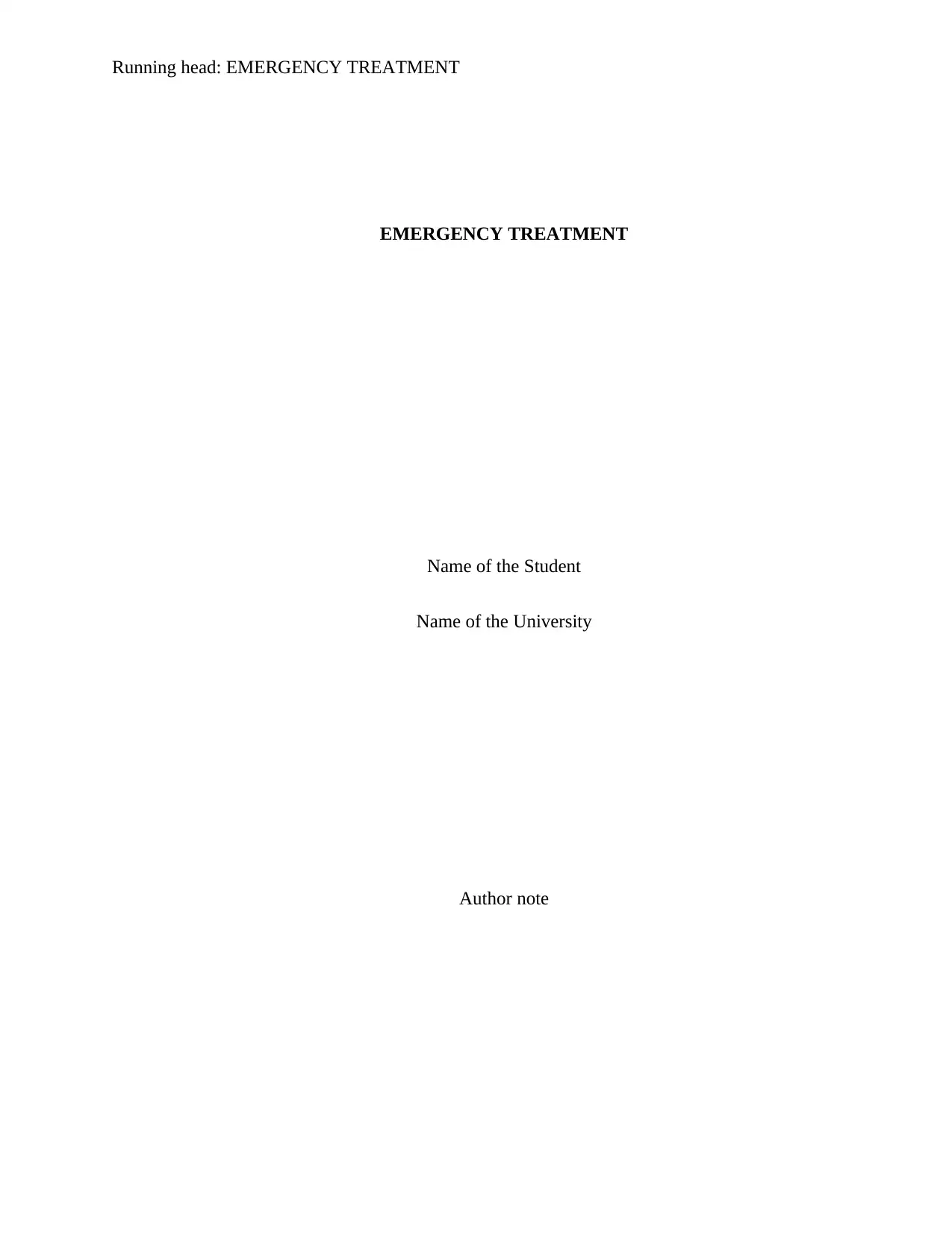
Running head: EMERGENCY TREATMENT
EMERGENCY TREATMENT
Name of the Student
Name of the University
Author note
EMERGENCY TREATMENT
Name of the Student
Name of the University
Author note
Paraphrase This Document
Need a fresh take? Get an instant paraphrase of this document with our AI Paraphraser
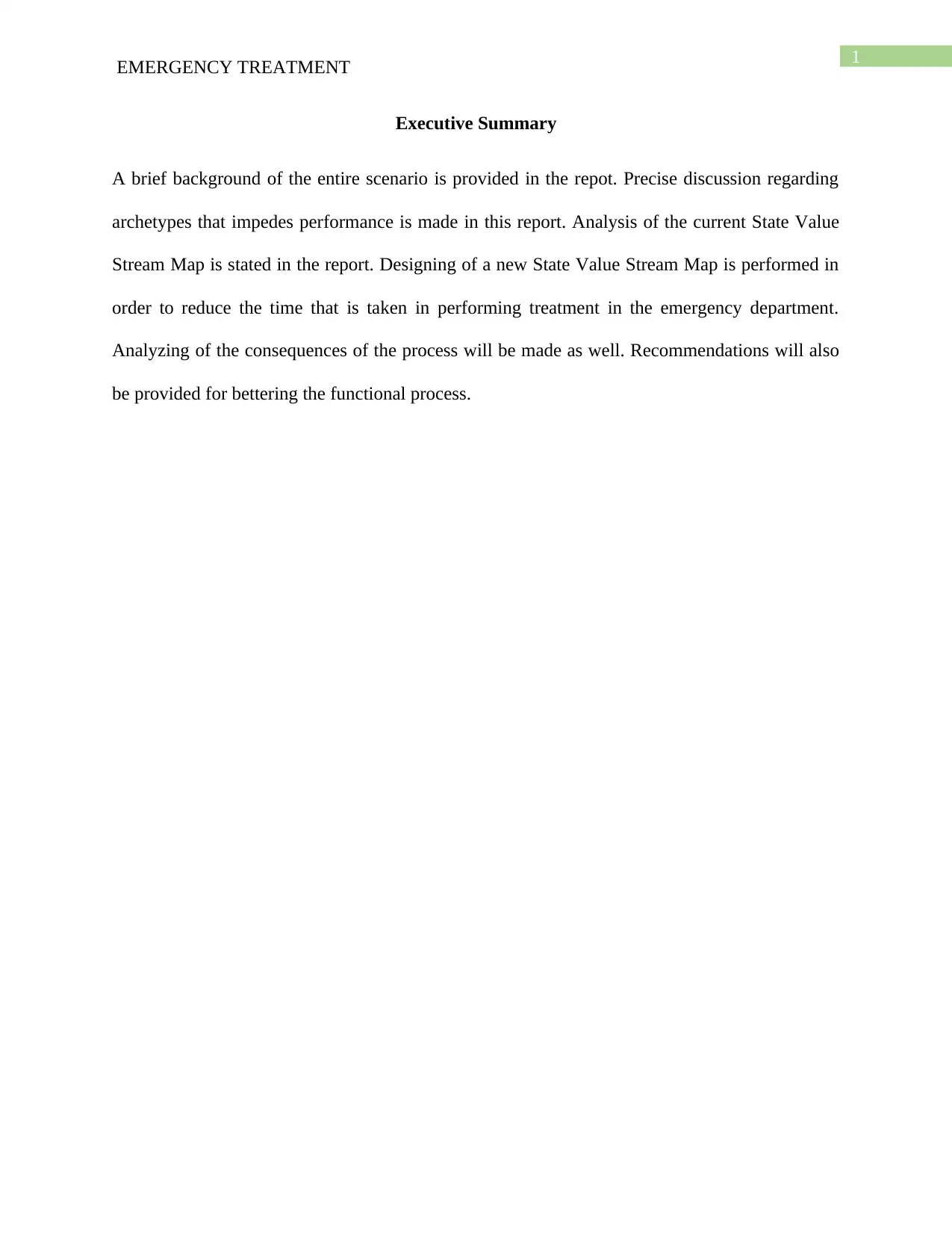
1
EMERGENCY TREATMENT
Executive Summary
A brief background of the entire scenario is provided in the repot. Precise discussion regarding
archetypes that impedes performance is made in this report. Analysis of the current State Value
Stream Map is stated in the report. Designing of a new State Value Stream Map is performed in
order to reduce the time that is taken in performing treatment in the emergency department.
Analyzing of the consequences of the process will be made as well. Recommendations will also
be provided for bettering the functional process.
EMERGENCY TREATMENT
Executive Summary
A brief background of the entire scenario is provided in the repot. Precise discussion regarding
archetypes that impedes performance is made in this report. Analysis of the current State Value
Stream Map is stated in the report. Designing of a new State Value Stream Map is performed in
order to reduce the time that is taken in performing treatment in the emergency department.
Analyzing of the consequences of the process will be made as well. Recommendations will also
be provided for bettering the functional process.
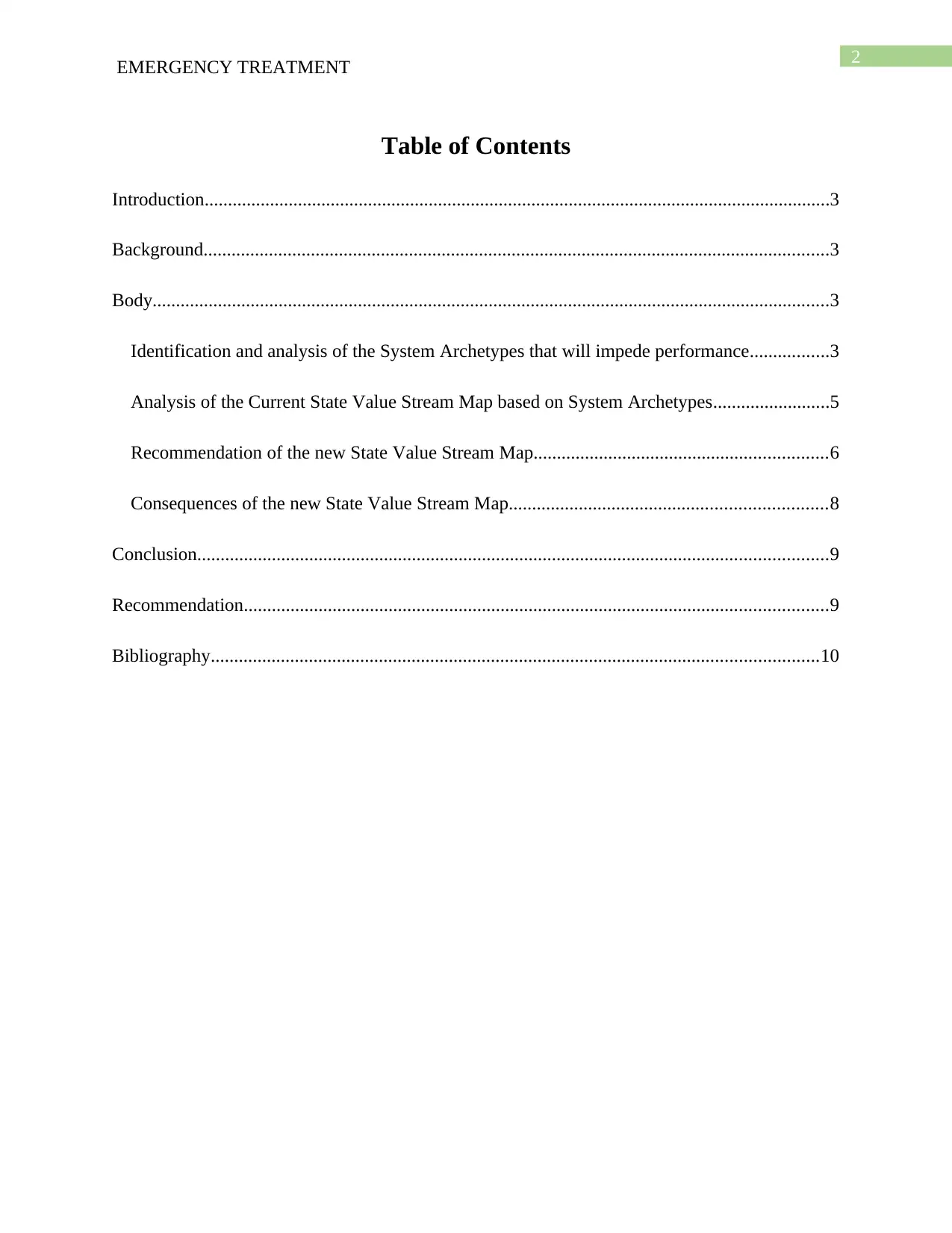
2
EMERGENCY TREATMENT
Table of Contents
Introduction......................................................................................................................................3
Background......................................................................................................................................3
Body.................................................................................................................................................3
Identification and analysis of the System Archetypes that will impede performance.................3
Analysis of the Current State Value Stream Map based on System Archetypes.........................5
Recommendation of the new State Value Stream Map...............................................................6
Consequences of the new State Value Stream Map....................................................................8
Conclusion.......................................................................................................................................9
Recommendation.............................................................................................................................9
Bibliography..................................................................................................................................10
EMERGENCY TREATMENT
Table of Contents
Introduction......................................................................................................................................3
Background......................................................................................................................................3
Body.................................................................................................................................................3
Identification and analysis of the System Archetypes that will impede performance.................3
Analysis of the Current State Value Stream Map based on System Archetypes.........................5
Recommendation of the new State Value Stream Map...............................................................6
Consequences of the new State Value Stream Map....................................................................8
Conclusion.......................................................................................................................................9
Recommendation.............................................................................................................................9
Bibliography..................................................................................................................................10
⊘ This is a preview!⊘
Do you want full access?
Subscribe today to unlock all pages.

Trusted by 1+ million students worldwide
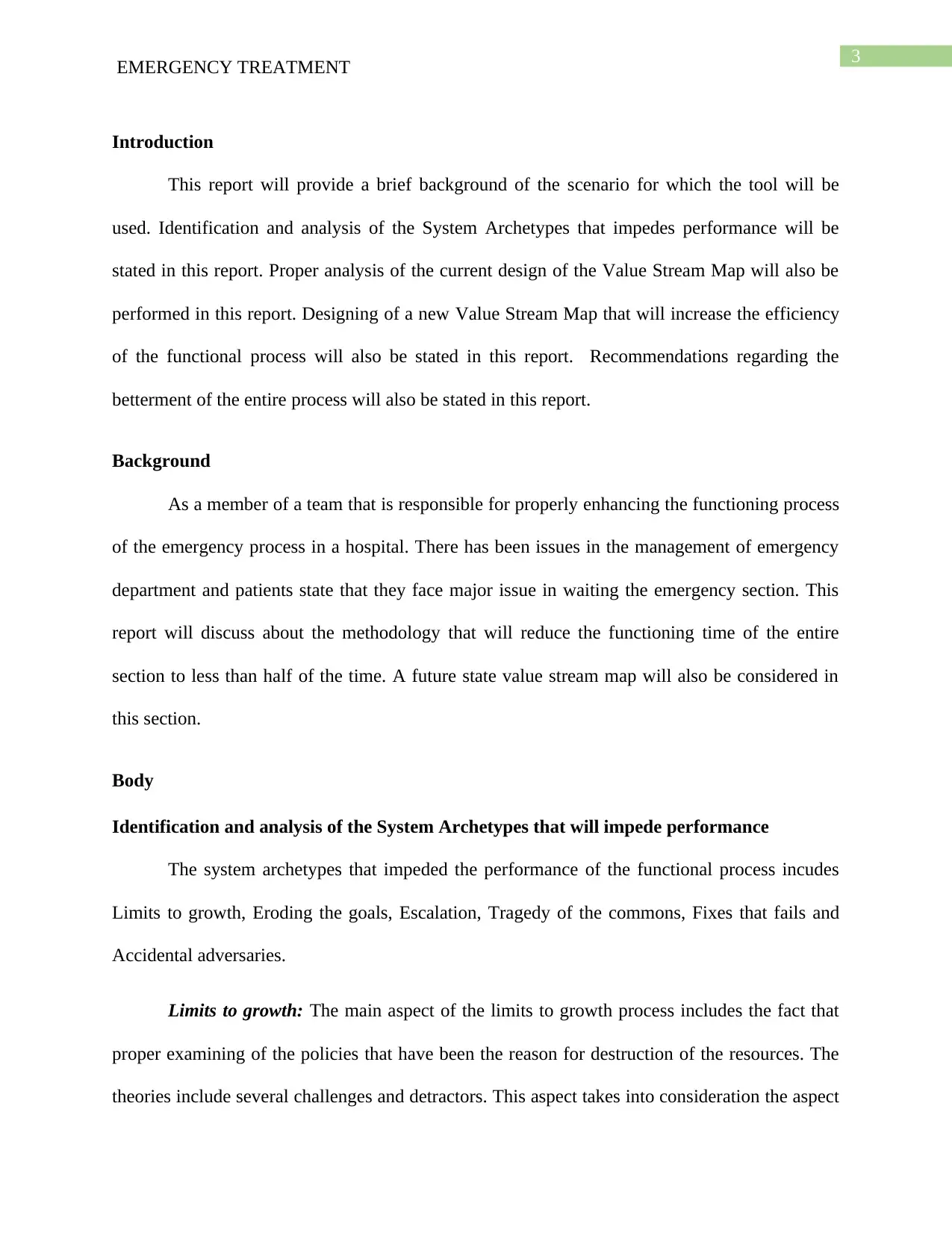
3
EMERGENCY TREATMENT
Introduction
This report will provide a brief background of the scenario for which the tool will be
used. Identification and analysis of the System Archetypes that impedes performance will be
stated in this report. Proper analysis of the current design of the Value Stream Map will also be
performed in this report. Designing of a new Value Stream Map that will increase the efficiency
of the functional process will also be stated in this report. Recommendations regarding the
betterment of the entire process will also be stated in this report.
Background
As a member of a team that is responsible for properly enhancing the functioning process
of the emergency process in a hospital. There has been issues in the management of emergency
department and patients state that they face major issue in waiting the emergency section. This
report will discuss about the methodology that will reduce the functioning time of the entire
section to less than half of the time. A future state value stream map will also be considered in
this section.
Body
Identification and analysis of the System Archetypes that will impede performance
The system archetypes that impeded the performance of the functional process incudes
Limits to growth, Eroding the goals, Escalation, Tragedy of the commons, Fixes that fails and
Accidental adversaries.
Limits to growth: The main aspect of the limits to growth process includes the fact that
proper examining of the policies that have been the reason for destruction of the resources. The
theories include several challenges and detractors. This aspect takes into consideration the aspect
EMERGENCY TREATMENT
Introduction
This report will provide a brief background of the scenario for which the tool will be
used. Identification and analysis of the System Archetypes that impedes performance will be
stated in this report. Proper analysis of the current design of the Value Stream Map will also be
performed in this report. Designing of a new Value Stream Map that will increase the efficiency
of the functional process will also be stated in this report. Recommendations regarding the
betterment of the entire process will also be stated in this report.
Background
As a member of a team that is responsible for properly enhancing the functioning process
of the emergency process in a hospital. There has been issues in the management of emergency
department and patients state that they face major issue in waiting the emergency section. This
report will discuss about the methodology that will reduce the functioning time of the entire
section to less than half of the time. A future state value stream map will also be considered in
this section.
Body
Identification and analysis of the System Archetypes that will impede performance
The system archetypes that impeded the performance of the functional process incudes
Limits to growth, Eroding the goals, Escalation, Tragedy of the commons, Fixes that fails and
Accidental adversaries.
Limits to growth: The main aspect of the limits to growth process includes the fact that
proper examining of the policies that have been the reason for destruction of the resources. The
theories include several challenges and detractors. This aspect takes into consideration the aspect
Paraphrase This Document
Need a fresh take? Get an instant paraphrase of this document with our AI Paraphraser
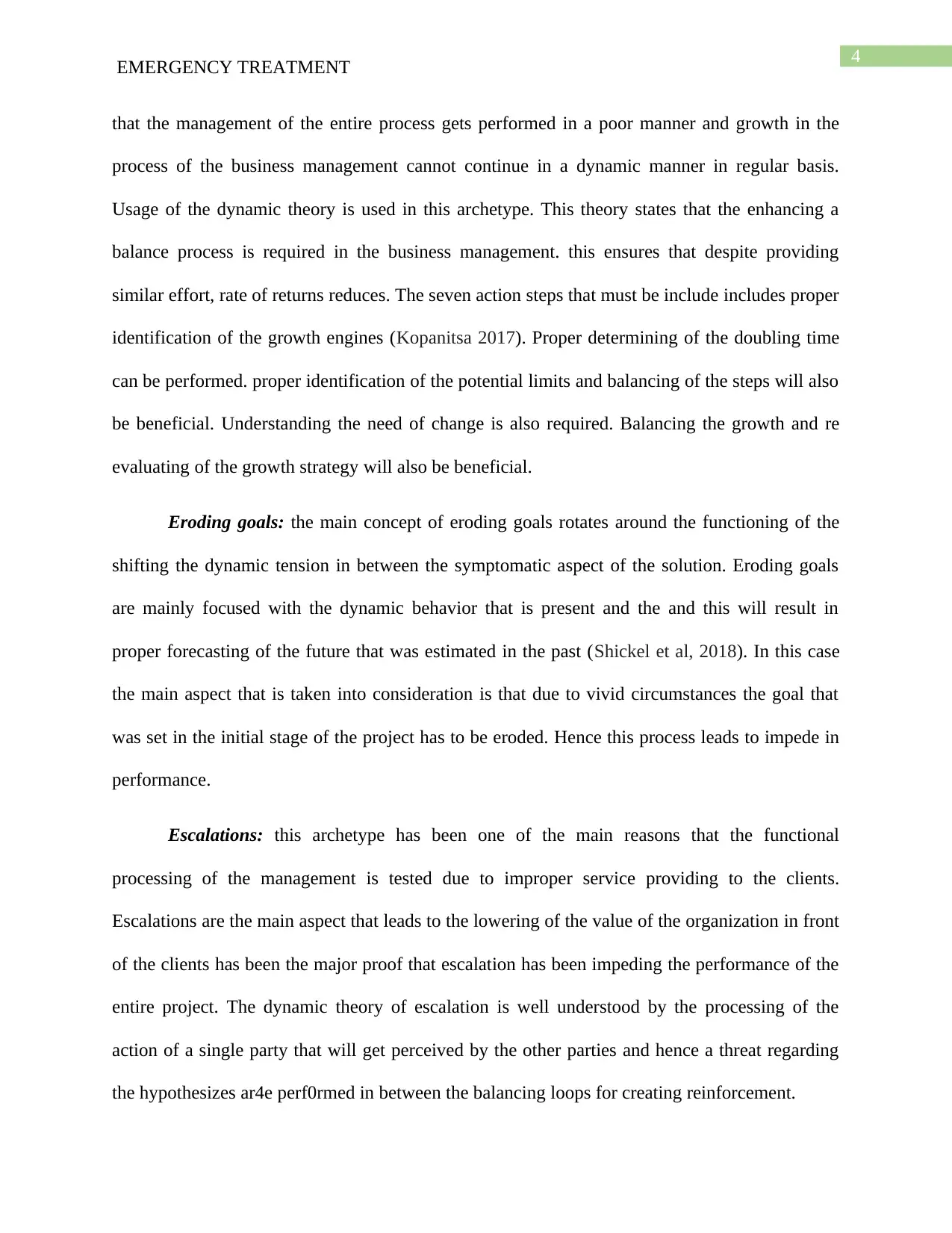
4
EMERGENCY TREATMENT
that the management of the entire process gets performed in a poor manner and growth in the
process of the business management cannot continue in a dynamic manner in regular basis.
Usage of the dynamic theory is used in this archetype. This theory states that the enhancing a
balance process is required in the business management. this ensures that despite providing
similar effort, rate of returns reduces. The seven action steps that must be include includes proper
identification of the growth engines (Kopanitsa 2017). Proper determining of the doubling time
can be performed. proper identification of the potential limits and balancing of the steps will also
be beneficial. Understanding the need of change is also required. Balancing the growth and re
evaluating of the growth strategy will also be beneficial.
Eroding goals: the main concept of eroding goals rotates around the functioning of the
shifting the dynamic tension in between the symptomatic aspect of the solution. Eroding goals
are mainly focused with the dynamic behavior that is present and the and this will result in
proper forecasting of the future that was estimated in the past (Shickel et al, 2018). In this case
the main aspect that is taken into consideration is that due to vivid circumstances the goal that
was set in the initial stage of the project has to be eroded. Hence this process leads to impede in
performance.
Escalations: this archetype has been one of the main reasons that the functional
processing of the management is tested due to improper service providing to the clients.
Escalations are the main aspect that leads to the lowering of the value of the organization in front
of the clients has been the major proof that escalation has been impeding the performance of the
entire project. The dynamic theory of escalation is well understood by the processing of the
action of a single party that will get perceived by the other parties and hence a threat regarding
the hypothesizes ar4e perf0rmed in between the balancing loops for creating reinforcement.
EMERGENCY TREATMENT
that the management of the entire process gets performed in a poor manner and growth in the
process of the business management cannot continue in a dynamic manner in regular basis.
Usage of the dynamic theory is used in this archetype. This theory states that the enhancing a
balance process is required in the business management. this ensures that despite providing
similar effort, rate of returns reduces. The seven action steps that must be include includes proper
identification of the growth engines (Kopanitsa 2017). Proper determining of the doubling time
can be performed. proper identification of the potential limits and balancing of the steps will also
be beneficial. Understanding the need of change is also required. Balancing the growth and re
evaluating of the growth strategy will also be beneficial.
Eroding goals: the main concept of eroding goals rotates around the functioning of the
shifting the dynamic tension in between the symptomatic aspect of the solution. Eroding goals
are mainly focused with the dynamic behavior that is present and the and this will result in
proper forecasting of the future that was estimated in the past (Shickel et al, 2018). In this case
the main aspect that is taken into consideration is that due to vivid circumstances the goal that
was set in the initial stage of the project has to be eroded. Hence this process leads to impede in
performance.
Escalations: this archetype has been one of the main reasons that the functional
processing of the management is tested due to improper service providing to the clients.
Escalations are the main aspect that leads to the lowering of the value of the organization in front
of the clients has been the major proof that escalation has been impeding the performance of the
entire project. The dynamic theory of escalation is well understood by the processing of the
action of a single party that will get perceived by the other parties and hence a threat regarding
the hypothesizes ar4e perf0rmed in between the balancing loops for creating reinforcement.
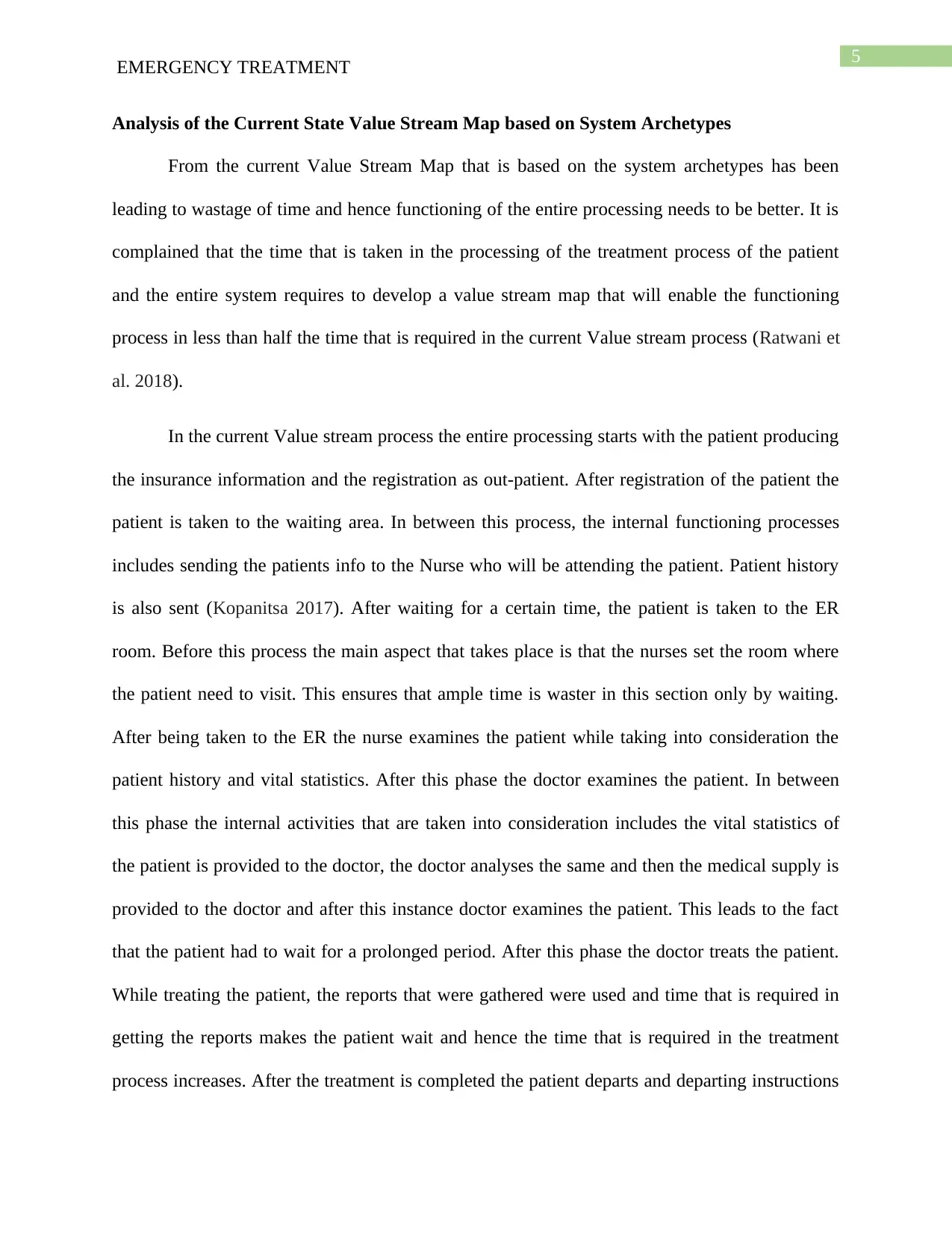
5
EMERGENCY TREATMENT
Analysis of the Current State Value Stream Map based on System Archetypes
From the current Value Stream Map that is based on the system archetypes has been
leading to wastage of time and hence functioning of the entire processing needs to be better. It is
complained that the time that is taken in the processing of the treatment process of the patient
and the entire system requires to develop a value stream map that will enable the functioning
process in less than half the time that is required in the current Value stream process (Ratwani et
al. 2018).
In the current Value stream process the entire processing starts with the patient producing
the insurance information and the registration as out-patient. After registration of the patient the
patient is taken to the waiting area. In between this process, the internal functioning processes
includes sending the patients info to the Nurse who will be attending the patient. Patient history
is also sent (Kopanitsa 2017). After waiting for a certain time, the patient is taken to the ER
room. Before this process the main aspect that takes place is that the nurses set the room where
the patient need to visit. This ensures that ample time is waster in this section only by waiting.
After being taken to the ER the nurse examines the patient while taking into consideration the
patient history and vital statistics. After this phase the doctor examines the patient. In between
this phase the internal activities that are taken into consideration includes the vital statistics of
the patient is provided to the doctor, the doctor analyses the same and then the medical supply is
provided to the doctor and after this instance doctor examines the patient. This leads to the fact
that the patient had to wait for a prolonged period. After this phase the doctor treats the patient.
While treating the patient, the reports that were gathered were used and time that is required in
getting the reports makes the patient wait and hence the time that is required in the treatment
process increases. After the treatment is completed the patient departs and departing instructions
EMERGENCY TREATMENT
Analysis of the Current State Value Stream Map based on System Archetypes
From the current Value Stream Map that is based on the system archetypes has been
leading to wastage of time and hence functioning of the entire processing needs to be better. It is
complained that the time that is taken in the processing of the treatment process of the patient
and the entire system requires to develop a value stream map that will enable the functioning
process in less than half the time that is required in the current Value stream process (Ratwani et
al. 2018).
In the current Value stream process the entire processing starts with the patient producing
the insurance information and the registration as out-patient. After registration of the patient the
patient is taken to the waiting area. In between this process, the internal functioning processes
includes sending the patients info to the Nurse who will be attending the patient. Patient history
is also sent (Kopanitsa 2017). After waiting for a certain time, the patient is taken to the ER
room. Before this process the main aspect that takes place is that the nurses set the room where
the patient need to visit. This ensures that ample time is waster in this section only by waiting.
After being taken to the ER the nurse examines the patient while taking into consideration the
patient history and vital statistics. After this phase the doctor examines the patient. In between
this phase the internal activities that are taken into consideration includes the vital statistics of
the patient is provided to the doctor, the doctor analyses the same and then the medical supply is
provided to the doctor and after this instance doctor examines the patient. This leads to the fact
that the patient had to wait for a prolonged period. After this phase the doctor treats the patient.
While treating the patient, the reports that were gathered were used and time that is required in
getting the reports makes the patient wait and hence the time that is required in the treatment
process increases. After the treatment is completed the patient departs and departing instructions
⊘ This is a preview!⊘
Do you want full access?
Subscribe today to unlock all pages.

Trusted by 1+ million students worldwide
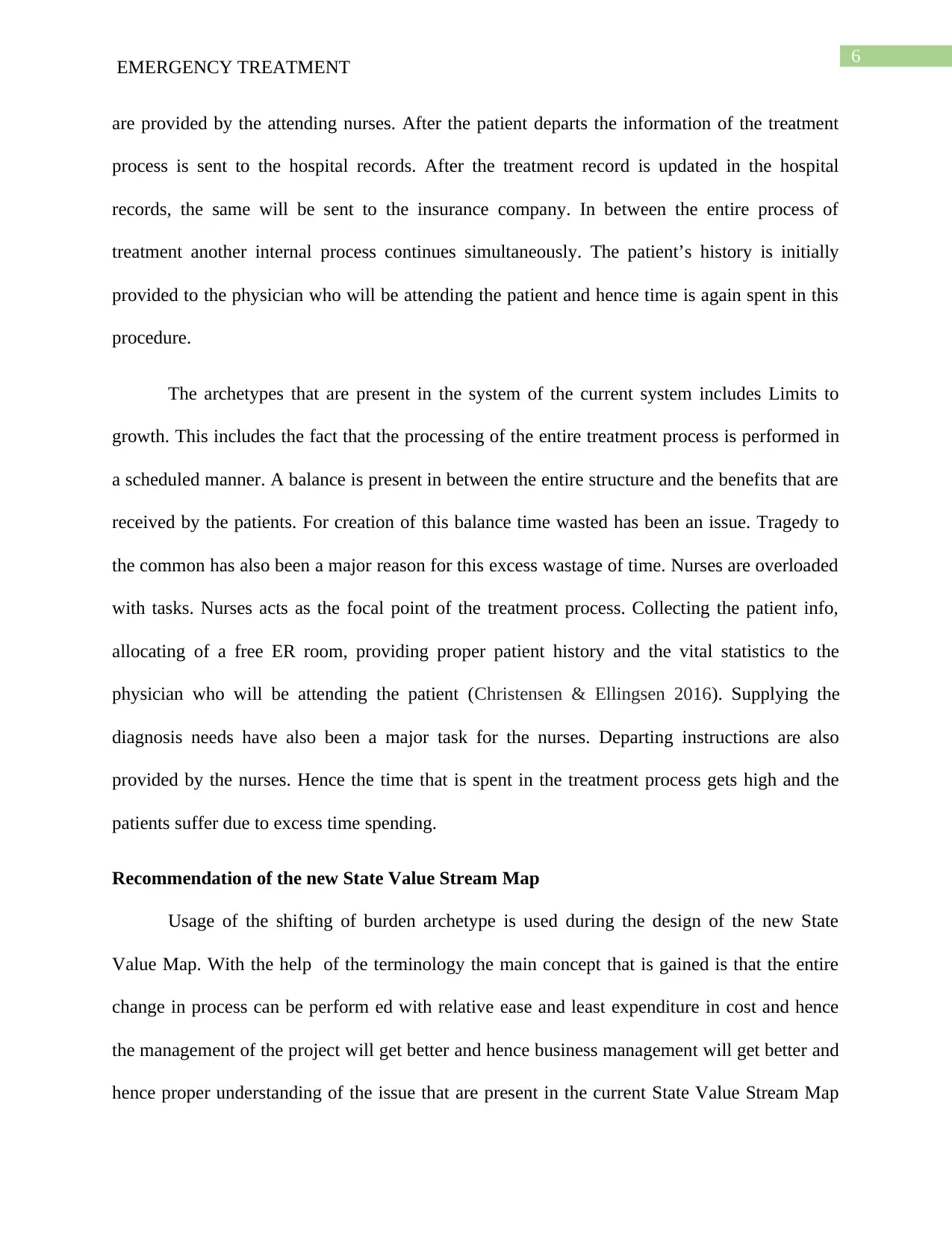
6
EMERGENCY TREATMENT
are provided by the attending nurses. After the patient departs the information of the treatment
process is sent to the hospital records. After the treatment record is updated in the hospital
records, the same will be sent to the insurance company. In between the entire process of
treatment another internal process continues simultaneously. The patient’s history is initially
provided to the physician who will be attending the patient and hence time is again spent in this
procedure.
The archetypes that are present in the system of the current system includes Limits to
growth. This includes the fact that the processing of the entire treatment process is performed in
a scheduled manner. A balance is present in between the entire structure and the benefits that are
received by the patients. For creation of this balance time wasted has been an issue. Tragedy to
the common has also been a major reason for this excess wastage of time. Nurses are overloaded
with tasks. Nurses acts as the focal point of the treatment process. Collecting the patient info,
allocating of a free ER room, providing proper patient history and the vital statistics to the
physician who will be attending the patient (Christensen & Ellingsen 2016). Supplying the
diagnosis needs have also been a major task for the nurses. Departing instructions are also
provided by the nurses. Hence the time that is spent in the treatment process gets high and the
patients suffer due to excess time spending.
Recommendation of the new State Value Stream Map
Usage of the shifting of burden archetype is used during the design of the new State
Value Map. With the help of the terminology the main concept that is gained is that the entire
change in process can be perform ed with relative ease and least expenditure in cost and hence
the management of the project will get better and hence business management will get better and
hence proper understanding of the issue that are present in the current State Value Stream Map
EMERGENCY TREATMENT
are provided by the attending nurses. After the patient departs the information of the treatment
process is sent to the hospital records. After the treatment record is updated in the hospital
records, the same will be sent to the insurance company. In between the entire process of
treatment another internal process continues simultaneously. The patient’s history is initially
provided to the physician who will be attending the patient and hence time is again spent in this
procedure.
The archetypes that are present in the system of the current system includes Limits to
growth. This includes the fact that the processing of the entire treatment process is performed in
a scheduled manner. A balance is present in between the entire structure and the benefits that are
received by the patients. For creation of this balance time wasted has been an issue. Tragedy to
the common has also been a major reason for this excess wastage of time. Nurses are overloaded
with tasks. Nurses acts as the focal point of the treatment process. Collecting the patient info,
allocating of a free ER room, providing proper patient history and the vital statistics to the
physician who will be attending the patient (Christensen & Ellingsen 2016). Supplying the
diagnosis needs have also been a major task for the nurses. Departing instructions are also
provided by the nurses. Hence the time that is spent in the treatment process gets high and the
patients suffer due to excess time spending.
Recommendation of the new State Value Stream Map
Usage of the shifting of burden archetype is used during the design of the new State
Value Map. With the help of the terminology the main concept that is gained is that the entire
change in process can be perform ed with relative ease and least expenditure in cost and hence
the management of the project will get better and hence business management will get better and
hence proper understanding of the issue that are present in the current State Value Stream Map
Paraphrase This Document
Need a fresh take? Get an instant paraphrase of this document with our AI Paraphraser
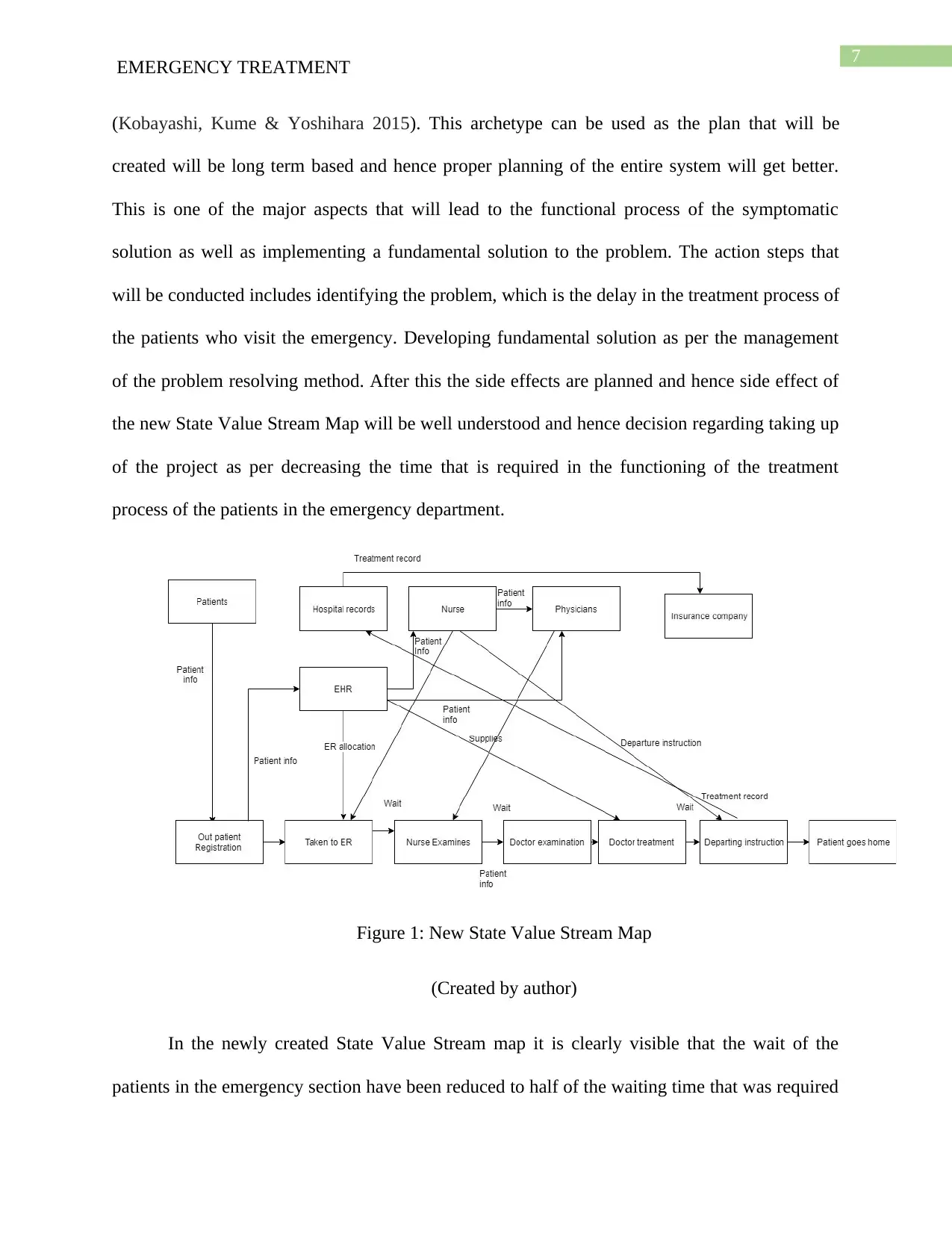
7
EMERGENCY TREATMENT
(Kobayashi, Kume & Yoshihara 2015). This archetype can be used as the plan that will be
created will be long term based and hence proper planning of the entire system will get better.
This is one of the major aspects that will lead to the functional process of the symptomatic
solution as well as implementing a fundamental solution to the problem. The action steps that
will be conducted includes identifying the problem, which is the delay in the treatment process of
the patients who visit the emergency. Developing fundamental solution as per the management
of the problem resolving method. After this the side effects are planned and hence side effect of
the new State Value Stream Map will be well understood and hence decision regarding taking up
of the project as per decreasing the time that is required in the functioning of the treatment
process of the patients in the emergency department.
Figure 1: New State Value Stream Map
(Created by author)
In the newly created State Value Stream map it is clearly visible that the wait of the
patients in the emergency section have been reduced to half of the waiting time that was required
EMERGENCY TREATMENT
(Kobayashi, Kume & Yoshihara 2015). This archetype can be used as the plan that will be
created will be long term based and hence proper planning of the entire system will get better.
This is one of the major aspects that will lead to the functional process of the symptomatic
solution as well as implementing a fundamental solution to the problem. The action steps that
will be conducted includes identifying the problem, which is the delay in the treatment process of
the patients who visit the emergency. Developing fundamental solution as per the management
of the problem resolving method. After this the side effects are planned and hence side effect of
the new State Value Stream Map will be well understood and hence decision regarding taking up
of the project as per decreasing the time that is required in the functioning of the treatment
process of the patients in the emergency department.
Figure 1: New State Value Stream Map
(Created by author)
In the newly created State Value Stream map it is clearly visible that the wait of the
patients in the emergency section have been reduced to half of the waiting time that was required
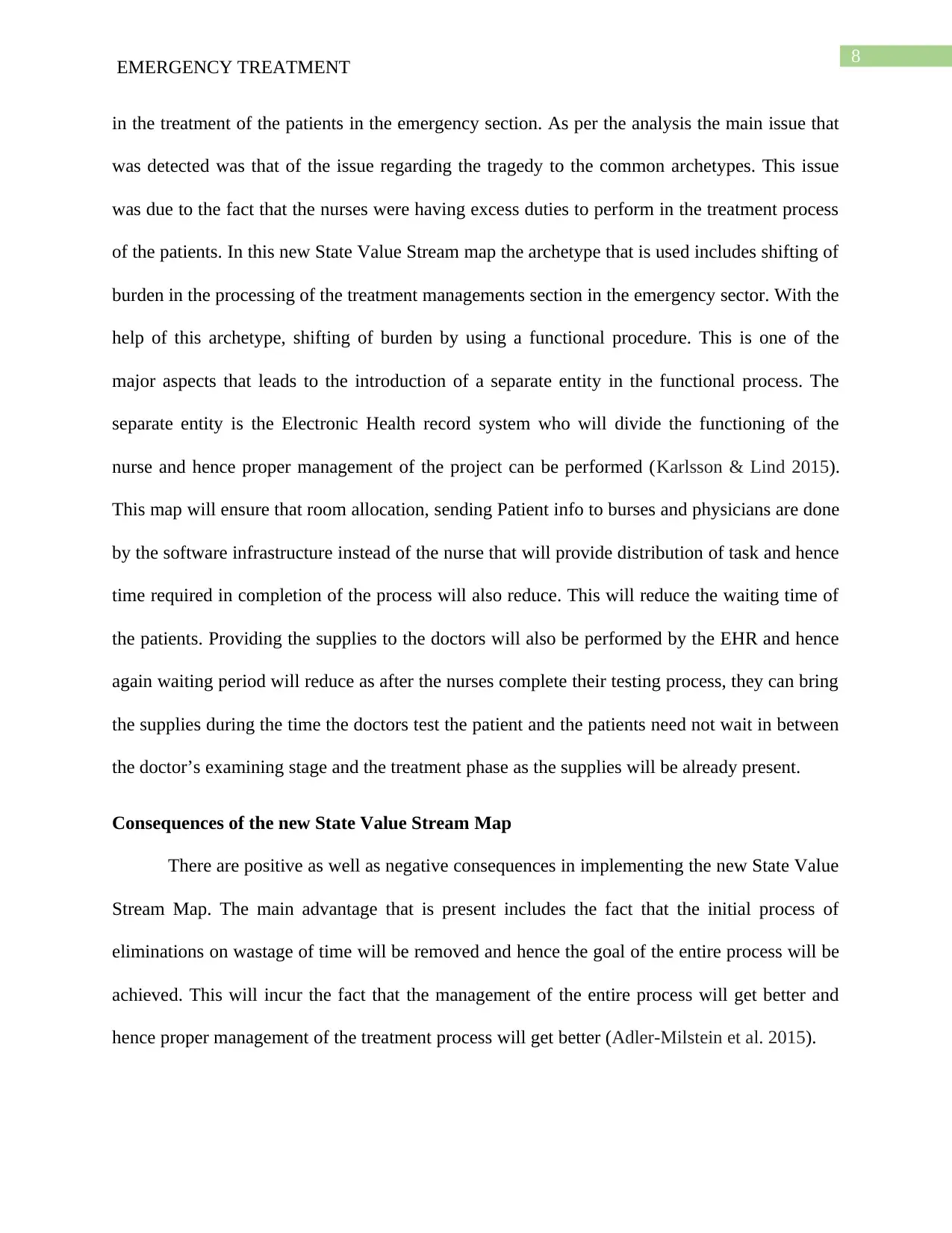
8
EMERGENCY TREATMENT
in the treatment of the patients in the emergency section. As per the analysis the main issue that
was detected was that of the issue regarding the tragedy to the common archetypes. This issue
was due to the fact that the nurses were having excess duties to perform in the treatment process
of the patients. In this new State Value Stream map the archetype that is used includes shifting of
burden in the processing of the treatment managements section in the emergency sector. With the
help of this archetype, shifting of burden by using a functional procedure. This is one of the
major aspects that leads to the introduction of a separate entity in the functional process. The
separate entity is the Electronic Health record system who will divide the functioning of the
nurse and hence proper management of the project can be performed (Karlsson & Lind 2015).
This map will ensure that room allocation, sending Patient info to burses and physicians are done
by the software infrastructure instead of the nurse that will provide distribution of task and hence
time required in completion of the process will also reduce. This will reduce the waiting time of
the patients. Providing the supplies to the doctors will also be performed by the EHR and hence
again waiting period will reduce as after the nurses complete their testing process, they can bring
the supplies during the time the doctors test the patient and the patients need not wait in between
the doctor’s examining stage and the treatment phase as the supplies will be already present.
Consequences of the new State Value Stream Map
There are positive as well as negative consequences in implementing the new State Value
Stream Map. The main advantage that is present includes the fact that the initial process of
eliminations on wastage of time will be removed and hence the goal of the entire process will be
achieved. This will incur the fact that the management of the entire process will get better and
hence proper management of the treatment process will get better (Adler-Milstein et al. 2015).
EMERGENCY TREATMENT
in the treatment of the patients in the emergency section. As per the analysis the main issue that
was detected was that of the issue regarding the tragedy to the common archetypes. This issue
was due to the fact that the nurses were having excess duties to perform in the treatment process
of the patients. In this new State Value Stream map the archetype that is used includes shifting of
burden in the processing of the treatment managements section in the emergency sector. With the
help of this archetype, shifting of burden by using a functional procedure. This is one of the
major aspects that leads to the introduction of a separate entity in the functional process. The
separate entity is the Electronic Health record system who will divide the functioning of the
nurse and hence proper management of the project can be performed (Karlsson & Lind 2015).
This map will ensure that room allocation, sending Patient info to burses and physicians are done
by the software infrastructure instead of the nurse that will provide distribution of task and hence
time required in completion of the process will also reduce. This will reduce the waiting time of
the patients. Providing the supplies to the doctors will also be performed by the EHR and hence
again waiting period will reduce as after the nurses complete their testing process, they can bring
the supplies during the time the doctors test the patient and the patients need not wait in between
the doctor’s examining stage and the treatment phase as the supplies will be already present.
Consequences of the new State Value Stream Map
There are positive as well as negative consequences in implementing the new State Value
Stream Map. The main advantage that is present includes the fact that the initial process of
eliminations on wastage of time will be removed and hence the goal of the entire process will be
achieved. This will incur the fact that the management of the entire process will get better and
hence proper management of the treatment process will get better (Adler-Milstein et al. 2015).
⊘ This is a preview!⊘
Do you want full access?
Subscribe today to unlock all pages.

Trusted by 1+ million students worldwide
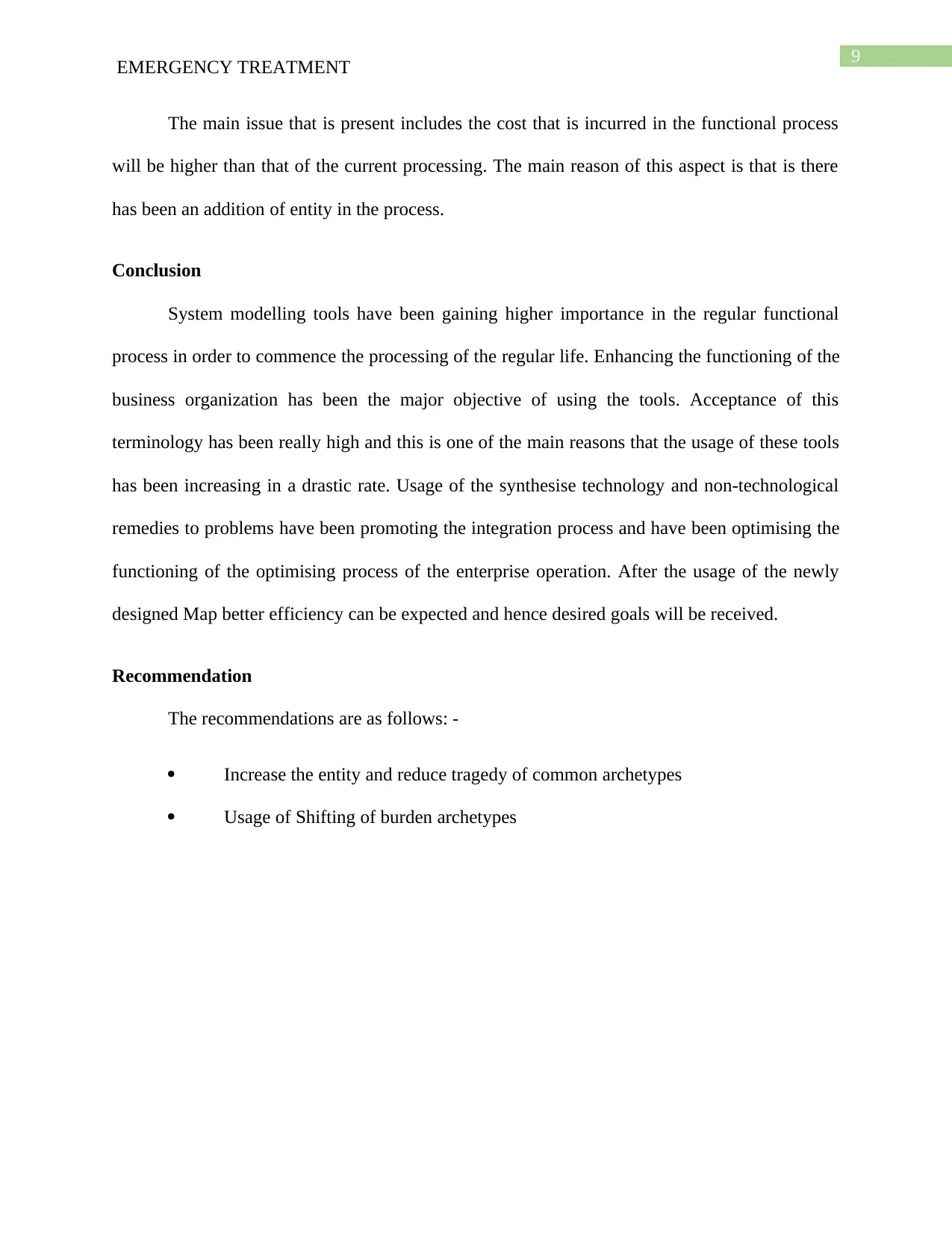
9
EMERGENCY TREATMENT
The main issue that is present includes the cost that is incurred in the functional process
will be higher than that of the current processing. The main reason of this aspect is that is there
has been an addition of entity in the process.
Conclusion
System modelling tools have been gaining higher importance in the regular functional
process in order to commence the processing of the regular life. Enhancing the functioning of the
business organization has been the major objective of using the tools. Acceptance of this
terminology has been really high and this is one of the main reasons that the usage of these tools
has been increasing in a drastic rate. Usage of the synthesise technology and non-technological
remedies to problems have been promoting the integration process and have been optimising the
functioning of the optimising process of the enterprise operation. After the usage of the newly
designed Map better efficiency can be expected and hence desired goals will be received.
Recommendation
The recommendations are as follows: -
Increase the entity and reduce tragedy of common archetypes
Usage of Shifting of burden archetypes
EMERGENCY TREATMENT
The main issue that is present includes the cost that is incurred in the functional process
will be higher than that of the current processing. The main reason of this aspect is that is there
has been an addition of entity in the process.
Conclusion
System modelling tools have been gaining higher importance in the regular functional
process in order to commence the processing of the regular life. Enhancing the functioning of the
business organization has been the major objective of using the tools. Acceptance of this
terminology has been really high and this is one of the main reasons that the usage of these tools
has been increasing in a drastic rate. Usage of the synthesise technology and non-technological
remedies to problems have been promoting the integration process and have been optimising the
functioning of the optimising process of the enterprise operation. After the usage of the newly
designed Map better efficiency can be expected and hence desired goals will be received.
Recommendation
The recommendations are as follows: -
Increase the entity and reduce tragedy of common archetypes
Usage of Shifting of burden archetypes
Paraphrase This Document
Need a fresh take? Get an instant paraphrase of this document with our AI Paraphraser
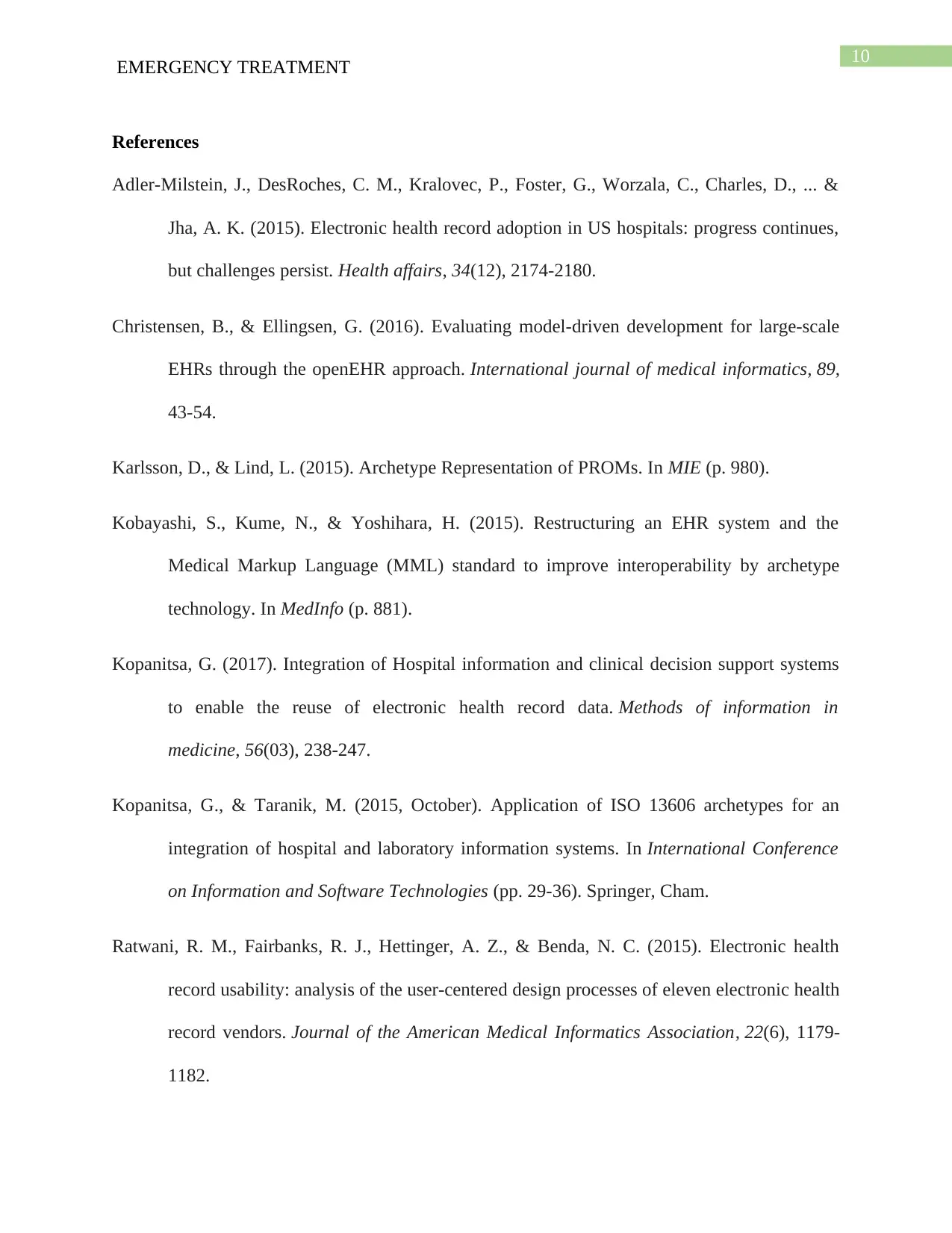
10
EMERGENCY TREATMENT
References
Adler-Milstein, J., DesRoches, C. M., Kralovec, P., Foster, G., Worzala, C., Charles, D., ... &
Jha, A. K. (2015). Electronic health record adoption in US hospitals: progress continues,
but challenges persist. Health affairs, 34(12), 2174-2180.
Christensen, B., & Ellingsen, G. (2016). Evaluating model-driven development for large-scale
EHRs through the openEHR approach. International journal of medical informatics, 89,
43-54.
Karlsson, D., & Lind, L. (2015). Archetype Representation of PROMs. In MIE (p. 980).
Kobayashi, S., Kume, N., & Yoshihara, H. (2015). Restructuring an EHR system and the
Medical Markup Language (MML) standard to improve interoperability by archetype
technology. In MedInfo (p. 881).
Kopanitsa, G. (2017). Integration of Hospital information and clinical decision support systems
to enable the reuse of electronic health record data. Methods of information in
medicine, 56(03), 238-247.
Kopanitsa, G., & Taranik, M. (2015, October). Application of ISO 13606 archetypes for an
integration of hospital and laboratory information systems. In International Conference
on Information and Software Technologies (pp. 29-36). Springer, Cham.
Ratwani, R. M., Fairbanks, R. J., Hettinger, A. Z., & Benda, N. C. (2015). Electronic health
record usability: analysis of the user-centered design processes of eleven electronic health
record vendors. Journal of the American Medical Informatics Association, 22(6), 1179-
1182.
EMERGENCY TREATMENT
References
Adler-Milstein, J., DesRoches, C. M., Kralovec, P., Foster, G., Worzala, C., Charles, D., ... &
Jha, A. K. (2015). Electronic health record adoption in US hospitals: progress continues,
but challenges persist. Health affairs, 34(12), 2174-2180.
Christensen, B., & Ellingsen, G. (2016). Evaluating model-driven development for large-scale
EHRs through the openEHR approach. International journal of medical informatics, 89,
43-54.
Karlsson, D., & Lind, L. (2015). Archetype Representation of PROMs. In MIE (p. 980).
Kobayashi, S., Kume, N., & Yoshihara, H. (2015). Restructuring an EHR system and the
Medical Markup Language (MML) standard to improve interoperability by archetype
technology. In MedInfo (p. 881).
Kopanitsa, G. (2017). Integration of Hospital information and clinical decision support systems
to enable the reuse of electronic health record data. Methods of information in
medicine, 56(03), 238-247.
Kopanitsa, G., & Taranik, M. (2015, October). Application of ISO 13606 archetypes for an
integration of hospital and laboratory information systems. In International Conference
on Information and Software Technologies (pp. 29-36). Springer, Cham.
Ratwani, R. M., Fairbanks, R. J., Hettinger, A. Z., & Benda, N. C. (2015). Electronic health
record usability: analysis of the user-centered design processes of eleven electronic health
record vendors. Journal of the American Medical Informatics Association, 22(6), 1179-
1182.
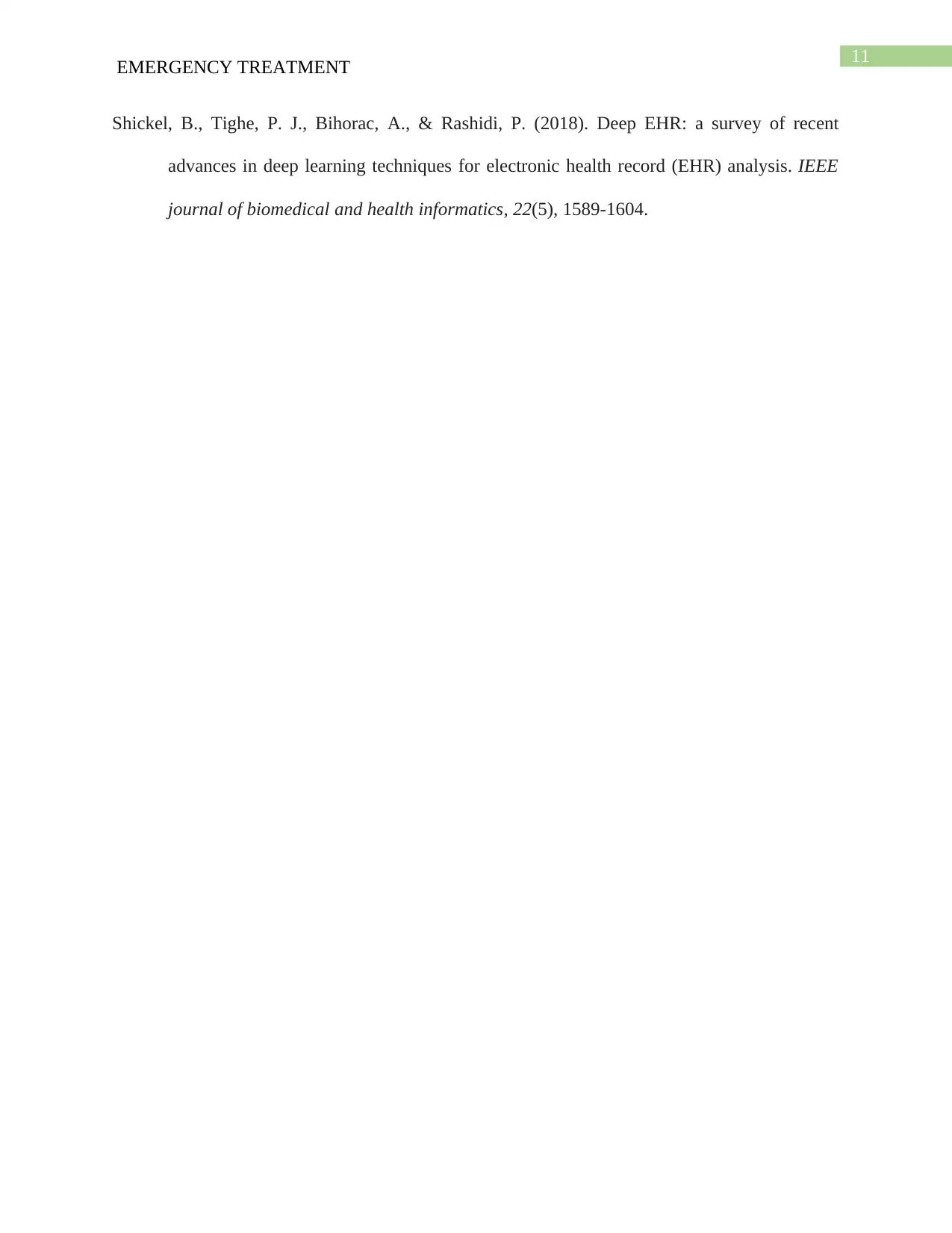
11
EMERGENCY TREATMENT
Shickel, B., Tighe, P. J., Bihorac, A., & Rashidi, P. (2018). Deep EHR: a survey of recent
advances in deep learning techniques for electronic health record (EHR) analysis. IEEE
journal of biomedical and health informatics, 22(5), 1589-1604.
EMERGENCY TREATMENT
Shickel, B., Tighe, P. J., Bihorac, A., & Rashidi, P. (2018). Deep EHR: a survey of recent
advances in deep learning techniques for electronic health record (EHR) analysis. IEEE
journal of biomedical and health informatics, 22(5), 1589-1604.
⊘ This is a preview!⊘
Do you want full access?
Subscribe today to unlock all pages.

Trusted by 1+ million students worldwide
1 out of 12
Related Documents
Your All-in-One AI-Powered Toolkit for Academic Success.
+13062052269
info@desklib.com
Available 24*7 on WhatsApp / Email
![[object Object]](/_next/static/media/star-bottom.7253800d.svg)
Unlock your academic potential
Copyright © 2020–2025 A2Z Services. All Rights Reserved. Developed and managed by ZUCOL.





